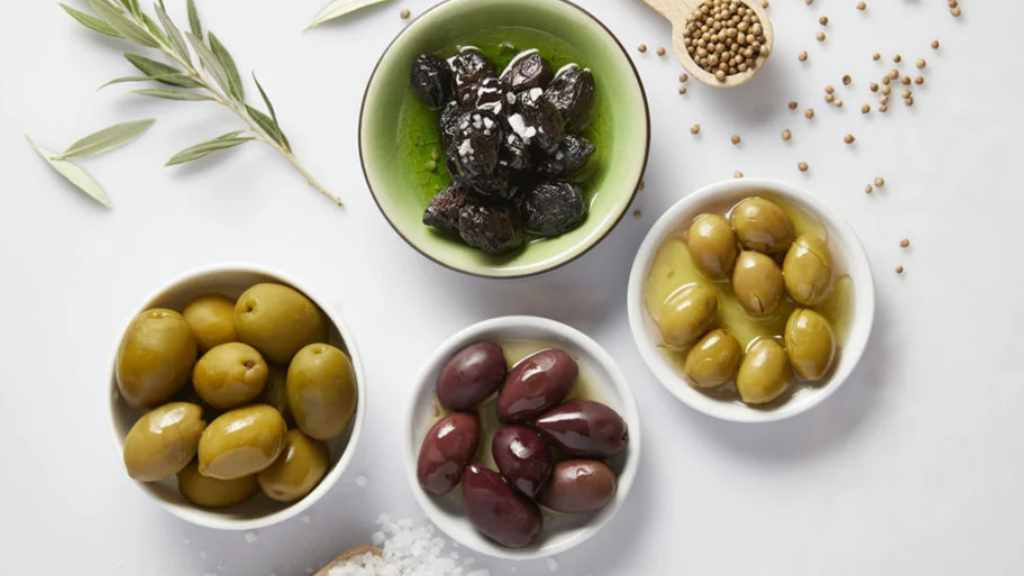At farmers’ markets and certain grocery stores around this time of year – from late September through October (depending on weather conditions and the region) – you’ll spot crates of freshly harvested table olives sold in bulk, completely unprocessed and raw. Their color is green, since they’re still somewhat unripe, but as the weeks go by, the market stalls will fill with purple, dark brown, and glossy black olives, depending on their stage of ripeness.
Greece has around 100 table olive varieties in total. According to agronomist and author Giorgos Kostelenos, the best-known can be grouped by size:
Large-fruited: Kalamon, Amfissis (Conservolea), Karidolia of Halkidiki, and Damaskiniolia (Chondreleia – Gaidoureleia).
Medium-fruited: Megaron, Kothreiki, Valanolia, Adramytini, Throumpolia, and Manaki.
Small-fruited: Koroneiki, Koutsourelia, Lianolia of Corfu, Mastoidis, Mavrolia of Messinia, and Thiaki.
To learn how to prepare homemade olives properly, we turned to Georgia Zerva-Boutsiani, cultivator of the Chondreleia Dolianon variety and producer of the award-winning table olives To Dolianitiko, who guided us through each stage of the process.
The Stages of olive preparation:
- Selecting and sourcing the fruit
- Washing with water
- Scoring or cracking
- Debittering
- Placing in brine and allowing to ferment
- Storing

Selecting and sourcing the fruit
Choose olives of your preferred variety directly from producers at farmers’ markets or elsewhere. Make sure they’re uniform in size (so they cure evenly), healthy, glossy, and free from insect marks or bruises.
Washing
Place the olives in a large colander and rinse them thoroughly under running water to remove dust and other debris. Drain well.
Scoring or cracking
For scored olives, use a razor blade or a sharp-pointed knife to lightly cut along the length of each olive without reaching the pit. Make three cuts around the fruit if it’s large, two if it’s medium, or just one for small-fruited varieties.
For cracked olives, use a small hammer to gently strike each olive just enough to split the flesh slightly.

Debittering
Slow method – with cold water: Place the scored or cracked olives in a deep bowl and cover with tap water. Change the water every two days. Continue this process for 10–12 days. Taste an olive; if it’s still bitter, leave it for another 1–2 days.
Quick method – with hot water: (This method is suitable only for firm, large-fruited olives such as Chondreleia, and only for scored, not cracked, ones, as the latter would soften too quickly.)
Place the scored olives in a deep bowl or basin and cover them with hot water. Change the water twice daily, always using hot water. Leave for a total of three days, tasting after that period; if they’re still bitter, leave them one day longer.
Placing in brine and fermentation
For about 1 kg of olives, mix 1 liter of lukewarm water with 100 g of coarse salt (i.e., salt equal to 10% of the water weight) in a deep bowl until the salt dissolves. Add the olives, stir well, cover, and leave for 10 days.
During this time, the natural sugars in the fruit promote the growth of lactic acid bacteria, which, together with the salt, act as a natural preservative and enhance the flavor and aroma of the olives.

Storing
You can leave the olives in the brine or drain them and transfer them to jars, topping up with olive oil. At this stage, you may also add vinegar (about 150 ml per 2-liter jar) and aromatic herbs or spices of your choice – for example, bay leaves, peppercorns, dried chili, or coriander seeds.
The flavor will vary depending on how they’re stored: if kept in brine, they’ll be saltier; if placed in oil and vinegar, the olives at the bottom of the jar will absorb more vinegar and develop a tangier flavor. Shake the jar occasionally to distribute the liquid evenly.
Unscored olives – Preserved in salt only
With this method, debittering and fermentation happen simultaneously. You can leave the olives whole, without scoring or cracking them, but the process takes much longer – about eight months.
For 1 kg of olives, you’ll need 100 g of coarse salt; for 10 kg, 1 kg of salt, and so on. In a plastic barrel or a large, deep bowl, layer the olives alternately with the salt. Seal the container tightly and keep it in a cool, shaded place (such as a cupboard) for eight months.
Every 10 days, roll or shake the container so the olives mix with the salt. Each month, check the texture; if the olives are softening too quickly, add a bit more coarse salt (for example, 50 g more if you began with 100 g).
After eight months, remove the olives, rinse and drain them, then transfer to jars and cover with high-quality olive oil. If desired, add flavorings such as bay leaves, black and green peppercorns, or slices of lemon.
Wrinkled Black Halkidiki Olives (Throubes)
Black olives are harvested when they’ve fully ripened and become oily on the tree (this year, the harvest began early). Choose the largest and cleanest fruits, wash and drain them.
In a plastic barrel or large bowl, layer the olives alternately with coarse salt (100 g per kilo of olives). Seal and store in a cool, shaded place – for example, in a kitchen cupboard – for about one month. Taste an olive; if needed, leave them another five days. Rinse off the salt, drain well, and pack into jars. Top up with olive oil.
Recipe by Stella Spanou, cook and author
Vinegared Kalamata olives
Buy the famous Kalamata olives, known for their almond shape and pointed tip, and follow the same procedure described above up to the debittering stage (using cold water). Drain well, place in a bowl, and mix with medium-coarse salt – about 100 g per kilo of olives. Cover and leave for 10 hours.
Rinse off the salt, drain again, and transfer to a jar or bowl. Cover with red wine vinegar, close, and let sit for two days. Drain off the vinegar and top up the jar with olive oil.
Recipe by Konstantinos Vassiliadis, chef and owner of the restaurant Ble Kanarini in Kalamata
This article was originally published in Greek at gastronomos.gr and in English in Greece Is (www.greece-is.com), a Kathimerini publishing initiative.


